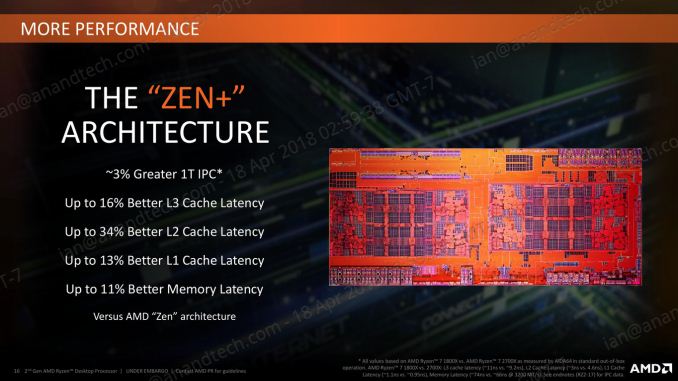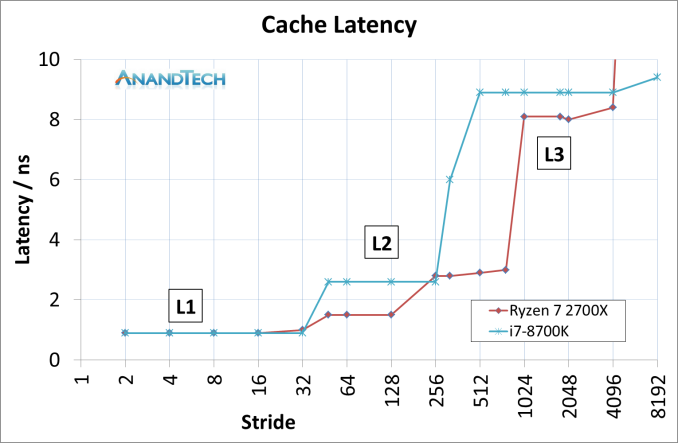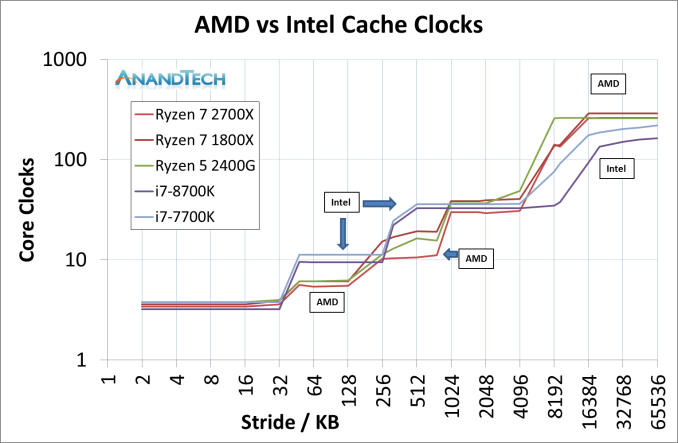The AMD 2nd Gen Ryzen Deep Dive: The 2700X, 2700, 2600X, and 2600 Tested
by Ian Cutress on April 19, 2018 9:00 AM ESTImprovements to the Cache Hierarchy
The biggest under-the-hood change for the Ryzen 2000-series processors is in the cache latency. AMD is claiming that they were able to knock one-cycle from L1 and L2 caches, several cycles from L3, and better DRAM performance. Because pure core IPC is intimately intertwined with the caches (the size, the latency, the bandwidth), these new numbers are leading AMD to claim that these new processors can offer a +3% IPC gain over the previous generation.
The numbers AMD gives are:
- 13% Better L1 Latency (1.10ns vs 0.95ns)
- 34% Better L2 Latency (4.6ns vs 3.0ns)
- 16% Better L3 Latency (11.0ns vs 9.2ns)
- 11% Better Memory Latency (74ns vs 66ns at DDR4-3200)
- Increased DRAM Frequency Support (DDR4-2666 vs DDR4-2933)
It is interesting that in the official slide deck AMD quotes latency measured as time, although in private conversations in our briefing it was discussed in terms of clock cycles. Ultimately latency measured as time can take advantage of other internal enhancements; however a pure engineer prefers to discuss clock cycles.
Naturally we went ahead to test the two aspects of this equation: are the cache metrics actually lower, and do we get an IPC uplift?
Cache Me Ousside, How Bow Dah?
For our testing, we use a memory latency checker over the stride range of the cache hierarchy of a single core. For this test we used the following:
- Ryzen 7 2700X (Zen+)
- Ryzen 5 2400G (Zen APU)
- Ryzen 7 1800X (Zen)
- Intel Core i7-8700K (Coffee Lake)
- Intel Core i7-7700K (Kaby Lake)
The most obvious comparison is between the AMD processors. Here we have the Ryzen 7 1800X from the initial launch, the Ryzen 5 2400G APU that pairs Zen cores with Vega graphics, and the new Ryzen 7 2700X processor.
This graph is logarithmic in both axes.
This graph shows that in every phase of the cache design, the newest Ryzen 7 2700X requires fewer core clocks. The biggest difference is on the L2 cache latency, but L3 has a sizeable gain as well. The reason that the L2 gain is so large, especially between the 1800X and 2700X, is an interesting story.
When AMD first launched the Ryzen 7 1800X, the L2 latency was tested and listed at 17 clocks. This was a little high – it turns out that the engineers had intended for the L2 latency to be 12 clocks initially, but run out of time to tune the firmware and layout before sending the design off to be manufactured, leaving 17 cycles as the best compromise based on what the design was capable of and did not cause issues. With Threadripper and the Ryzen APUs, AMD tweaked the design enough to hit an L2 latency of 12 cycles, which was not specifically promoted at the time despite the benefits it provides. Now with the Ryzen 2000-series, AMD has reduced it down further to 11 cycles. We were told that this was due to both the new manufacturing process but also additional tweaks made to ensure signal coherency. In our testing, we actually saw an average L2 latency of 10.4 cycles, down from 16.9 cycles in on the Ryzen 7 1800X.
The L3 difference is a little unexpected: AMD stated a 16% better latency: 11.0 ns to 9.2 ns. We saw a change from 10.7 ns to 8.1 ns, which was a drop from 39 cycles to 30 cycles.
Of course, we could not go without comparing AMD to Intel. This is where it got very interesting. Now the cache configurations between the Ryzen 7 2700X and Core i7-8700K are different:
| CPU Cache uArch Comparison | ||
| AMD Zen (Ryzen 1000) Zen+ (Ryzen 2000) |
Intel Kaby Lake (Core 7000) Coffee Lake (Core 8000) |
|
| L1-I Size | 64 KB/core | 32 KB/core |
| L1-I Assoc | 4-way | 8-way |
| L1-D Size | 32 KB/core | 32 KB/core |
| L1-D Assoc | 8-way | 8-way |
| L2 Size | 512 KB/core | 256 KB/core |
| L2 Assoc | 8-way | 4-way |
| L3 Size | 8 MB/CCX (2 MB/core) |
2 MB/core |
| L3 Assoc | 16-way | 16-way |
| L3 Type | Victim | Write-back |
AMD has a larger L2 cache, however the AMD L3 cache is a non-inclusive victim cache, which means it cannot be pre-fetched into unlike the Intel L3 cache.
This was an unexpected result, but we can see clearly that AMD has a latency timing advantage across the L2 and L3 caches. There is a sizable difference in DRAM, however the core performance metrics are here in the lower caches.
We can expand this out to include the three AMD chips, as well as Intel’s Coffee Lake and Kaby Lake cores.
This is a graph using cycles rather than timing latency: Intel has a small L1 advantage, however the larger L2 caches in AMD’s Zen designs mean that Intel has to hit the higher latency L3 earlier. Intel makes quick work of DRAM cycle latency however.














545 Comments
View All Comments
NWRMidnight - Sunday, April 22, 2018 - link
Considering they already stated they would be publishing their findings this coming week, you are wrong about not being able to provide clarification. But it is taking time because they have to go thru and run various tests with various setting changes to determine what is influencing their numbers. This is beyond what just running tests and writing up a review is. People want to know how they got their numbers, even at stock, and defaults, they have to go thru and turn off or on bios settings, windows settings, etc to determine and be able to explain the impact on the results.This pretty much doubles if not triples the time it would to do just a simple review. And since Ian was up for 36 hours straight to get the first review out (partially because they had to scrap 36 hours of testing results and start over). So, he had to actually go home and get some sleep so he could tackle this task with an energized and clear mind.
So, how about you learn some patience and realize that they will get the information to us, or would you rather have it all rushed without any real details? They also most likely have weekends off, so in reality, we should not expect anything until mid week this week.
John_M - Monday, April 23, 2018 - link
"partially because they had to scrap 36 hours of testing results and start over"Where was this mentioned and explained, please?
NWRMidnight - Monday, April 23, 2018 - link
talks about having to throw out some of the data, and the reason, at the bottom of this page of the review:https://www.anandtech.com/show/12625/amd-second-ge...
Here is Ian's comment on twitter:
https://twitter.com/IanCutress/status/987366840442...
John_M - Monday, April 23, 2018 - link
Do you mean this:"However, this is just AMD’s standard PB2: disabling it will disable PB2. Initially we turned it off, thinking it was a motherboard manufacturer tool, only to throw away some testing because there is this odd disconnect between AMD’s engineers and AMD’s marketing."
I didn't read the tweet so didn't make the connection.
RafaelHerschel - Monday, April 23, 2018 - link
A publication should either stand by its tests or not. If AnandTech is unsure about their results, they should temporarily pull the benchmarks since they might be misleading or place a much larger disclaimer.Ranger1065 - Monday, April 23, 2018 - link
Great news about avoiding Anandtech in future Rafael. Please make sure you stick to your word.RafaelHerschel - Monday, April 23, 2018 - link
@Ranger1065 I'll see this one out, and yes, then I'm gone for good. I don't understand why you are happy about people not visiting this site anymore. I'm pretty sure that AnandTech can use all the traffic they can get.It's sad that a once leading publication doesn't seem to have a place in the market anymore.
mapesdhs - Monday, May 14, 2018 - link
Perhaps we're just happy that people who think we live in a completely black & white world won't be hanging around. Nuance is dead in this SJW world.ET - Sunday, April 22, 2018 - link
The 2700 is quoted as $309 in all benchmarks. Should that be $299?MDD1963 - Sunday, April 22, 2018 - link
FFS, *please* tell me this (crappy 8700K results) is not a result of using bastardly patched Windows Enterprise for the gaming tests ...!(For all those folks at home benching games with Windows Enterprise...yeah, that happens :/ )